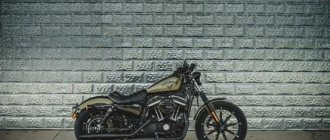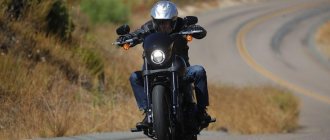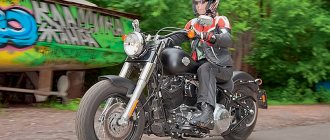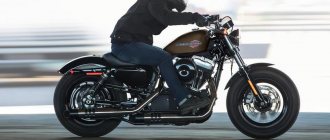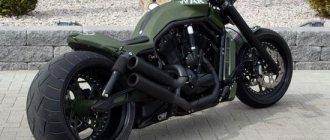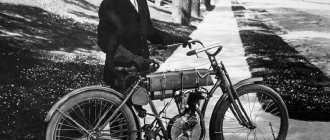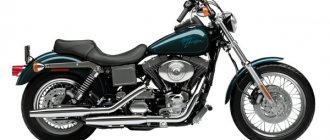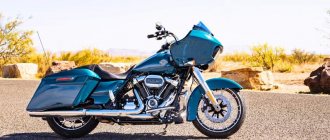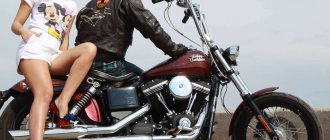Quartermile: custom Harley Davidson heritage softail
This year in Prague, Harley Davidson celebrated its 115th anniversary. Several craftsmen were invited to the celebration, each of whom presented their own custom Harley. The most notable was the creation of Julian von Oheimb, who stood on the podium at the World Customization Championship three times. A master from Germany runs a custom studio called One Way Machine. His main passion is transforming Harley motorcycles into original, sleek customs.
Harley Davidson Heritage Softail
The custom Harley Davidson Heritage Softail, which he built for the company’s anniversary, is a clear confirmation of this. The minimalist, dark-colored bobber is named Quartermile. But don't let the austere design and slick tires fool you: this is not a race bike at all. Once upon a time, Julian saw a custom Knucklehead with slicks built by Billy Lane (William David Lane is an American custom motorcycle builder, owner of Choppers Inc. in Melbourne, Florida). This motorcycle sank into his soul, many ideas were born in his head, which were embodied in Quartermile. In fact, the Quartermile became a motorcycle that simply should not have been born.
When Harley Davidson invited craftsmen to their celebration, they gave them a choice: present an existing custom or build a new one. At the time, the event was only four months away, with One Way Machine typically taking over a year to create a custom. Still, Julian decided to put together something new. All he needed was a suitable donor.
As luck would have it, Julian's father owned a 2007 Harley Davidson Heritage Softail that had once been imported from the United States. Once the donor issue was closed, it was time to think about the design. Julian pulled out old blueprints from the depths of his desk. He selected the best design elements, then tailored them to the Heritage Softail so it was road-legal. Julian explains that One Way Machine's customers are usually serious businessmen who are only willing to invest in perfectly designed and practical motorcycles. For this reason, it is extremely important that all laws and formalities are followed, so that after the show the slick tires are replaced with Avon tires.
The history of Harley-Davidson: how the motorcycle brand created fashion for custom
Harley and Davidson
William Sylvester Harley and Arthur Davidson began creating a motorized bicycle in the American town of Milwaukee in 1901. The place for inventions and test drives was an ordinary garage. The young people worked for three years before they realized that a bicycle without pedals could not conquer America. Therefore, it was decided to engage in more serious development and create a motorcycle.
The first motorcycle was released in 1903 and was called the Milwaukee Merkel. It had a 405 cc engine and weighed approximately 13 kg.
But the name Harley-Davidson went down in history in 1904. Then the motorcycle of William Sylvester Harley and Arthur Davidson raced and finished fourth. From that moment on, the friends began mass production of bikes in their garage.
By the way, later this same garage was moved to, where it stood for many years, as a memory of the first years of the life of the great brand.
A couple of years after the founding of the brand, the factory was producing 50 motorcycles a year, in 1907 150 models were produced, and between 1908 and 1909 motorcycle sales increased from 450 units to 1,149.
World War I
The British Army ordered 500 motorcycles from Harley-Davidson at the start of World War I. And in 1917, the US Army already placed a large order from the motorcycle brand. Thus, we can say that the military of England and America rode through the First World War on Harley-Davidson bikes, which were able to prove themselves at their best during this difficult time. During the entire war period, more than 20 thousand motorcycles were produced.
The rise of the brand
Harley-Davidson became the largest motorcycle manufacturer in the world in the 20s of the 20th century. In 1921, a Harley-Davidson driven by Otto Walker won the race for the first time, averaging over 100 mph (160 km/h).
In the same decade, motorcycles were improved and the 74-inch V-Twin engine appeared for the first time.
In 1925, the teardrop-shaped gas tank appeared for the first time. It became one of the distinctive characteristics of the brand and is still found on most modern motorcycle models.
In 1928, front brakes appeared on Harley-Davidson motorcycles.
The origins of customization
Customizing is the improvement and modification of a motorcycle according to the customer’s individual design. Customization originated in the 30s of the 20th century. Back then, buyers of Harley-Davidson motorcycles could order an art deco graphic design of an eagle on the gas tank.
“Motorcycles have always been something unique. They have never been and will never be a mass product. A motorcycle is a product that its owner, in his quest for self-expression, can take to its most extreme forms,” the quote belongs to Will G. Davidson.
The First World War was followed by the Second World War. At this time, Harley-Davidson continues to produce motorcycles for the military. The Liberator model, translated as “liberator,” has gone down in history. Motorcycles were supplied not only to the American army, but also to the USSR, where they were supplemented with a sidecar and a rear seat.
It is believed that the fashion for customization came after the Second World War. According to one version, motorcycles became very popular among the military and after the end of the war they continued to ride their favorite bikes. Since the design of all Harley-Davidson motorcycles of that period was in military style, the owners began to independently change the appearance of the bikes.
«Harley-Davidson continues to support this passion for customization to this day and produces a wide range of additional equipment and spare parts that can become a source of inspiration for you,” says the Harley-Davidson Ekaterinburg website.
All brand motorcycles are customized to suit the client and his needs. This applies not only to design, but also to technical characteristics: the height of the pedals, the distance between the seat and the handlebars, as well as means for caring for the motorcycle, since many owners prefer to take care of their Harley themselves.
Harley Owners Group (HOG)
Over its 118-year history, the brand’s lineup includes several dozen models. Today Harley-Davidson is not about motorcycles, it is about a lifestyle and attitude towards it.
All brand models have a unique, recognizable style and status, be it a chopper or a cruiser. Many people dream of a Harley as a symbol of freedom and speed, while others value the brotherhood that the brand has created over its hundred-year history.
Today, Harley-Davidson is chosen by politicians, rock stars, and businessmen. For like-minded people, the Harley Owners Group (HOG) was created in 1983. It brings together Harley owners and is a club of interests. Club members organize races, wear club paraphernalia and organize motorcycle festivals. The organization is global and has its own charter and rules.
By the way, the Harley Owners Group has a branch called Ladies of Harley.
© Online magazine “Global City” Svetlana Tsyganova
Hello riders! Another year has flown by! The 2021 season is ahead. For 2020. traveled almost 10,000 km. Every day from the dacha to work and back and rides on the weekends. My friends and I are in front, and our family is behind us in a car. We traveled throughout the Samara region and all the regions nearby. But that's another story. And this is a story about custom, but not “deep”. And such as not to change the functionality, give a slightly different style and not be afraid to go out on the track. And I did it! First, I painted an image onto the windshield. Then he began to slowly order from the States: running boards, a clock, a rear-view mirror, a seat, a trunk, a rear backrest, installed speakers, glued an eagle to the front fender, replaced the rear lamp with LEDs, changed the grips, installed reflectors and a windshield on the arms, a tank cover, medallion on the fake left tank cover, etc. and so on. and so on. In the process, LED lighting is installed on the bottom of the motorcycle for night visibility. Changed my equipment. Jacket with skulls and reflective light at night. I ordered a new development from England - a helmet with a rear-view mirror. It turned out good! What can I say about the mot? I start the season with gymkhana. Always. And among the club members he probably became the best in riding. Three times my training helped me out in 2021. Once, a woman in a jeep ahead changed her mind about driving through the intersection and stopped abruptly when the traffic light began to flash. I walked behind, 2 meters. Rear brake, with 0.5 second deceleration front brake. I'm slowing down. I see I don’t have time and go into the aisle. The second time it was night, the city stopped at an intersection, I stood calmly. In first gear, the clutch is depressed. Out of old habit, I look in the rear mirror. I see 9ka rushing by. On me. The guy started chatting with the girl. I signal. Squealing brakes. I drove away, drove out to the intersection, luckily there were no cars. He stops at the place where I stood a second ago. I turned off the engine and walked up to it. The poor fellow is white as chalk. The girl is shaking. I shook my finger at him and drove on. 3rd case. 3 stripes. I’m walking on the left, on the right, a minibus from the right lane, through two lanes, sharply maneuvers into my lane. Apparently he didn't look to the left. And then I probably ended up in his blind spot. I gasped and forward, so that he could see, but so as not to touch, I walked slightly towards him. There's a Camry coming towards you. It was 10 meters. The driver opened his mouth. But because I stepped on the gas and left the blind spot, the driver of the minivan saw me and sharply went to the right. I had enough time to maneuver into my lane. Then, by the way, the minivan driver apologized for a long time when we drove nearby. I ride gymkhana on average once a week. Necessarily. My mot is good. Managed. It’s a little heavy for the city, but I’m not being a hooligan either. On the highway I set it to cruise and food. I don’t like scalding, riding in convoys and in crowds. I rode with a friend all summer. He's on a Harley too. There is a Germany SP Connect holder on the steering wheel. I attach the phone, put on the book, or if it’s a city, turn on YouTube, connect Sena and go. The only neutral catches how my shepherd VEO executes commands, i.e. optional. And perhaps what brings me real discomfort is the spaced-apart turn signal switches. And so there are no complaints. From the word in general. My spendthrift! I have never regretted it! Happy new season everyone!
Tuning a Harley-Davidson motorcycle.
Harley-Davidson motorcycles are considered archaic.
Even their owners sometimes don’t realize how much their pets are actually stuffed with modern electronics.
Modern fuel injection with feedback, a knock control system, electronic protection against overheating at idle, brakes with automatic force distribution between the wheels and ABS, a keyless engine starting system with an immobilizer, smart automatic turn signals - this is not a complete list of everything, what lies behind the classic appearance of almost every Big Twin since 2007. We at DK Moto, together with Redhog Performance Tuning*, love and know Harley-Davidson motorcycles well. Especially in terms of the ECM (Engine Control Module) - the engine control unit. This is what we will talk about in this article.
You’ve probably heard that Harley is “strangled,” but you don’t know who “strangled” them and, most importantly, why. In short, every Harley-Davidson model must be certified by the EPA (Environmental Protection Agency) and CARB (Clean Air Resources Board) before being released to the public. First of all, the CO2 emissions and noise produced by the motorcycle are checked. In order to comply with the standards,
The company is forced to adjust the injection system so that the quality of the air-fuel mixture is close to 14.7:1 (almost 15 times more air than gasoline). This is exactly the ratio at which the mixture burns completely, BUT, unfortunately, it has nothing to do with either the performance of the engine or its durability.
A lean mixture burns hot, hence the frequent overheating of the engine, which is so familiar to owners of modern Harleys. Overheating does not help increase the life expectancy of the engine, and in addition, reduces rider comfort.
In addition to ECM calibration, to comply with environmental standards, the Company also uses “iron” methods - catalyst(s) in the exhaust system, valves on mufflers and air filters, which forcibly reduce the throughput of the engine, thereby literally STUFFING it.
What to do? How can you make your favorite motorcycle run for all the money you paid for it and ensure it has a long life? The first place to start is to reprogram the ECM so that the quality of the mixture matches YOUR goals and YOUR format for using the motorcycle, and not the whims of environmental bureaucrats. We've made a lot of motorcycles and heard a lot of questions from Harley-Davidson owners and destroyed a lot of myths. Below are some of them with answers:
- “I don’t need this, my motorcycle has standard intake and exhaust.”
No, everyone needs this. Even a fully stock motorcycle runs too lean and, as a result, hot. By installing efficient (read: allowing more air into the engine) components, unlucky owners further aggravate the situation, making the mixture already catastrophically lean.
- “I don’t need this, I have an “American”.”
In fact, it is necessary. American motorcycles comply with the same strict environmental standards, and among them there are also Californian versions, which have an EVEN poorer mixture!
- “My motorcycle rides well as it is.”
Great, he will do even better. Depending on the motorcycle model and the combination of components installed, we can add up to 15 percent of power and torque just by programming the ECM, without replacing the hardware!
- “I'm afraid the dealer will find out and void my warranty.”
It won’t recognize us, we disguise our “firmware” as standard ones, they have the same identifier and cannot be read by anyone but us. There is no “box” left “hanging” on the motorcycle that will give out (and may break over time). In addition, many dealers are our good friends and even (shhh!) clients.
- “I heard that my pistons (valves) will burn out.”
Just the opposite. They will burn out if you install tuning mufflers and a filter without taking care of the correct program. We have programs for any pipes and filters, including “exotic”. After our programming, the engine temperature in the hottest place (the head of the spark plugs) decreases by 20 degrees or more.
— “Your technologies are American, and we travel around Moscow. We have traffic jams here. And the gasoline is bad.”
In fact, we are Russians, we work half of each season in Russia and are well aware of Russian realities. All our “firmware” was developed by us and adapted for Moscow conditions. We can (although we do not recommend) make any most capricious motorcycle work without detonation on 92 gasoline and ride in a traffic jam “without gas” without jerking in first gear.
- “A 15 percent increase in power is great, but guess what, will it eat up?”
It won’t; on the contrary, consumption on the highway will decrease. The Harley-Davidson Touring will be able to travel up to 100 additional kilometers on one fill (of course, if you maintain a cruising speed of around 130 km/h). The motorcycles we tune rarely consume more than 5.5 liters of fuel per 100 km.
- “I like everything, but won’t my motorcycle be jerky and difficult to control?”
Most of our clients note that as a result of our work, the gearbox requires less attention, the motorcycle rides in any gear more smoothly, regardless of speed, and the “sixth” is finally made “driveable” - turned on from 60 km/h and forgotten.
“I like everything, but I would like to install the Stage1 kit first, camshafts, larger piston, ported heads.”
No problem, we will help you purchase the necessary spare parts. Moreover, we have our own dynamometer, we know WHICH components actually WORK, and we are happy to tell everyone about it.
- “OK, we’ve convinced you, we’ll do it! How much does it cost, how much time will it take, and what about the “native” firmware?”
ECM programming costs 20 thousand rubles (without dyno measurements), including lifetime support (any necessary firmware modifications, adjustments for new intake/exhaust components, etc.). The standard firmware is stored with us and can be sent to the client by email. By agreement we will arrive/fly anywhere, we are mobile. Programming takes 20-25 minutes and only requires a working battery in the motorcycle and an Internet connection.
If we haven’t touched on any questions in this post, please ask, we are available on all social networks, by phone, email and WhatsApp.
* Reliable partner of DK Moto.
